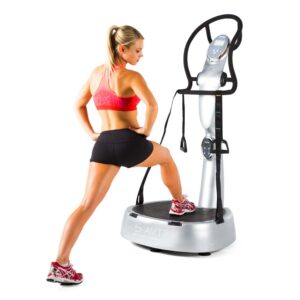During a normal strength training exercise routine our muscles move through a ‘progression of muscle fatigue’. This means that when a specific muscle is first stimulated, only a small portion of the total muscle belly fibers are being recruited to assist in the motion. As the workout motion continues, the core muscle fibers will begin to fatigue. Once the core muscle fiber enters a ‘fatigued’ state, other muscle tissues are now recruited to help assist and continue with the motion. An example of this is if you were to bend at the knees and hold a squat position, eventually your quadriceps and hamstring muscles would begin to tire. Assuming that you continued to hold this squat position, your leg muscles would begin to shake and thus stabilizer muscle tissue would be activated to allow you to continue to hold the squat position.
If your brain is telling your body to do something, your body will try and do the command until physically you can no longer perform the action. It can become a battle of ‘mind over matter’ as the saying goes. This ‘progression of fatigue’ is the eventual wearing down of all muscle tissue including white and red muscle fiber tissues.
Continuing to hold a squat position, the core muscles fibers begins to fatigue, the stabilizer muscle tissue begins to fatigue and your body generates more energy and fuel to keep the muscles going. As our bodies perform strenuous exercise, we begin to breathe faster as we attempt to shuttle more oxygen to our working muscles. The body prefers to generate most of its energy using aerobic methods, meaning with oxygen.
Some circumstances, however, –such as when our predecessors had to evade the historical saber tooth tiger or lifting heavy weights in the gym–require energy production faster than our bodies can adequately deliver oxygen. In those cases, the working muscles generate energy anaerobically. This energy comes from glucose through a process called glycolysis, in which glucose is broken down or metabolized into a substance called pyruvate through a series of steps. When the body has plenty of oxygen, pyruvate is shuttled to an aerobic pathway to be further broken down for more energy.
But when oxygen is limited, the body temporarily converts pyruvate into a substance called lactate, which allows glucose breakdown–and thus energy production–to continue. The working muscle cells can continue this type of anaerobic energy production at high rates for one to three minutes, during which time lactate can accumulate to high levels.* Stephen M. Roth, a professor in the department of kinesiology at the University of Maryland. Lactic acid’s role in muscle soreness is now recognized as more a positive part of a healthy metabolism, according to research from George A. Brooks. He has found lactic acid to be a critical substance used to provide energy, dispose of dietary carbohydrate, produce blood glucose and liver glycogen, and even promote survival in stressful situations.
To understand how vibration training works, it’s important to first understand the basic structure of your muscles. There are three main types of muscle fibers: Slow-Twitch (red muscle fibers, used in maintaining posture, endurance activities such as running a marathon); Fast-Twitch A (red to pink muscle fibers, used in walking, running, sprinting) and Fast-Twitch B (white muscle fibers, used in rapid, intense movements such as throwing a ball or weightlifting).
“Most skeletal muscles of the body are a mixture of all three types of muscle fibers, but their proportion varies depending on the usual action of the muscles,” Gerard Tortora and Sandra Reynolds Grabowski state in their 1996 book “Principles of Anatomy and Physiology.”
“Endurance-type exercises such as running or swimming, cause a gradual transformation of some fast glycotic fibers into fast oxidation. … On the other hand, exercises that require great strength for short periods of time, such as weightlifting, produce an increase in the size and strength of fast glycotic fibers.”
According to Tortora and Grabowski, “If a skeletal muscle or group of skeletal muscles is over-stimulated, the strength of contraction becomes progressively weaker until the muscle no longer responds. “The inability of a muscle to maintain its strength and contraction or tension is called muscle fatigue,” Tortora and Grabowski continue. “It occurs when a muscle cannot produce enough ATP to meet its needs.”
ATP, or active transport, is the movement of substances across cell membranes against a concentration gradient, requiring the expenditure of energy. Whether a fiber is a slow- or fast-twitch muscle depends on how quickly it splits ATP. Fast-twitch muscles split ATP more quickly, and are more defined in sprinters and athletes, who perform heavy weightlifting and need powerful bursts.
With vibration training, all three types of skeletal muscles are instantaneously called into service because of the near-immediate level of fatigue, no longer is there a ‘progression of muscle fatigue’ as in normal strength training. That’s something even most well-conditioned people don’t achieve in their workouts because they don’t have the time, know-how or ability to perform all the different types of exercises required to activate all the different types of muscle fibers.
With muscles being stimulated to near peak capacity through vibration training, it maximizes muscle strengthening and flexibility, along with a host of other positive effects on your body. Weight loss can be achieved, cardio health and circulation improved, bone health increased, anabolic hormones secreted and reflex pathways re-connected. Whole body vibration training will even help the muscles produce and work through lactic acid.
The fact is that a full-on ‘progression of muscle fatigue’ requires a high level of energy, motivation and possible wear and tear on ligaments, tendons and joints. With vertical motion vibration machines like the 3G Cardio AVT™ Vibration Machines, the “progression of muscle fatigue” is no longer accomplished during stages or over a period of time; it is instantaneous as all muscle fibers are recruited at the same time in order to respond to the upward force of the vibration platform movements.
Accelerated Vibration Training causes the muscles to contract in response to the plate vibrations and movements — up to an incredible 25-50 times per second, Marco Cardinale’s research showed — resulting in rapid contractions and accelerated results. The vibrations create instability, which the body senses and reflexively contracts muscle tissue involuntarily to stabilize and react to the stimuli. 3G Cardio AVT Vibration machines vibrate up and down in a vertical motion at adjustable hertz setting of up to a staggering 50Hz to utilize the body’s own reflexes.
The basic physics for “Force” were defined by Sir Isaac Newton’s equation: F = m * a (Force equals mass times acceleration). In traditional methods of strength training (dumbbells, bar bells and home gyms) the “mass” is created by the actual weight plates, dumbbells or weight stacks. In the case of vibration plate machines, the “mass” is the user’s own body weight and gravity.
The “force” is generated by the upward vibrations coming from the platform which cause a user’s muscle tissue to activate and react up to 50 times per second. In fact, up to 97 percent of the muscle fibers are activated instantaneously, compared to as little as 20 percent with traditional methods — and in a lot less time.
There is arguably not a better method to safely and effectively fatigue the muscle than vibration training. A small example of some of the numerous findings on vibration training include remarkable increases in jump height, mechanical power and increased flexibility in the low back and hip joint.
Vibration training has also been found in countless studies to help people with diseases or disorders to improve their conditions. An example is J.G. Gianutsos, who found that people with Parkinson’s disease improved dramatic progress in being able to walk.
You can actually get great results from Accelerated Vibration Training in a little as 1 – 3 minutes a day! Due to the potential level of exertion required to perform certain exercises, it really does not take much to feel the effects.
We would like to point out that there is no magic pill and in order to achieve the maximum benefits from a vibration machine, it is idea to perform a series of exercises and have workouts that last 10 minutes – 30 minutes per day.



